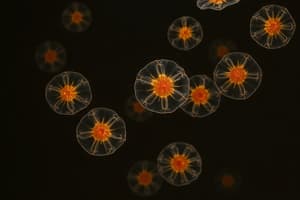Podcast
Questions and Answers
What percentage of the recirculating pool of small lymphocytes do B cells form?
What percentage of the recirculating pool of small lymphocytes do B cells form?
- 20%
- 15% (correct)
- 10%
- 5%
Which of the following does not represent a subtype of B lymphocytes?
Which of the following does not represent a subtype of B lymphocytes?
- Memory B cells
- Regulatory B cells (correct)
- Immature B cells
- Pre-B cells
Which surface molecules do mature B cells express?
Which surface molecules do mature B cells express?
- IgA and IgE
- CD3 and CD8
- IgM and IgD (correct)
- IgG and IgM
Which organ is primarily involved in the maturation of B lymphocytes?
Which organ is primarily involved in the maturation of B lymphocytes?
What is the primary function of B cells after antigen stimulation?
What is the primary function of B cells after antigen stimulation?
Which cluster of differentiation (CD) molecule is expressed on immature B cells?
Which cluster of differentiation (CD) molecule is expressed on immature B cells?
Where do mature B cells primarily await the arrival of specific antigens?
Where do mature B cells primarily await the arrival of specific antigens?
What type of immunity are lymphocytes primarily associated with?
What type of immunity are lymphocytes primarily associated with?
What is the origin of T lymphocytes?
What is the origin of T lymphocytes?
Which type of cells mature T lymphocytes in the thymus?
Which type of cells mature T lymphocytes in the thymus?
What is true about double-negative immature thymocytes?
What is true about double-negative immature thymocytes?
What component of the TCR is responsible for recognizing specific peptide antigens?
What component of the TCR is responsible for recognizing specific peptide antigens?
What function does CD3 serve in T cells?
What function does CD3 serve in T cells?
How do T lymphocytes recognize antigens?
How do T lymphocytes recognize antigens?
What distinguishes different clones of T lymphocytes?
What distinguishes different clones of T lymphocytes?
Which of the following statements about T lymphocyte maturation is incorrect?
Which of the following statements about T lymphocyte maturation is incorrect?
Which receptor is NOT associated with natural killer cells?
Which receptor is NOT associated with natural killer cells?
What percentage of peripheral lymphocytes do natural killer cells comprise?
What percentage of peripheral lymphocytes do natural killer cells comprise?
Which of the following is a main function of natural killer cells?
Which of the following is a main function of natural killer cells?
What role do LAK cells serve in cancer therapy?
What role do LAK cells serve in cancer therapy?
In immunotherapy, which lymphocyte subtype is known for its spontaneous non-specific killing of tumor cells?
In immunotherapy, which lymphocyte subtype is known for its spontaneous non-specific killing of tumor cells?
What happens to T cells that recognize MHC class I on thymic epithelial cells during maturation?
What happens to T cells that recognize MHC class I on thymic epithelial cells during maturation?
What is the main function of T helper cells (CD4) within the immune response?
What is the main function of T helper cells (CD4) within the immune response?
Which T cell subtype is primarily responsible for terminating the immune response?
Which T cell subtype is primarily responsible for terminating the immune response?
What is the typical ratio of CD4 to CD8 T cells in most tissues?
What is the typical ratio of CD4 to CD8 T cells in most tissues?
During negative selection, what normally happens to self-reactive T cell clones?
During negative selection, what normally happens to self-reactive T cell clones?
Which T cell subtype is responsible for the fast and strong secondary immune response upon re-exposure to an antigen?
Which T cell subtype is responsible for the fast and strong secondary immune response upon re-exposure to an antigen?
What is a characteristic function of T cytotoxic (CD8) cells?
What is a characteristic function of T cytotoxic (CD8) cells?
Which statement accurately describes the life span and location of T helper cells?
Which statement accurately describes the life span and location of T helper cells?
Flashcards are hidden until you start studying
Study Notes
Lymphocytes
- Lymphocytes are a type of white blood cell and the unique cells of adaptive immunity.
- CD molecules (Cluster of Differentiation):
- Cell surface molecules expressed on all immune cells
- Each type of immune cell has a particular CD number
- Examples:
- T cells: CD3
- Th cells: CD4
- Tc cells: CD8
- B cells: CD19
B Lymphocytes
- Origin and Maturation:
- Develop from bone marrow stem cells
- Mature in the generative lymphoid organs (bone marrow)
- Circulate through the blood to complete maturation in secondary lymphoid organs
- Subtypes:
- Pre-B cells: Lack surface immunoglobulins but express IgM heavy chains mu in their cytoplasm
- Immature B cells: Express IgM receptors on the surface
- Mature B cells: Express IgM and IgD molecules on the surface as receptors for antigens
- **Memory B cells: ** Express IgG, IgA, or IgE on the surface
- Percentage, Life Span, and Location:
- B cells constitute about 15% of the recirculating pool of small lymphocytes
- Short life span (days or weeks)
- Found in the germinal center of lymph nodes, the white pulp of the spleen, and the gut-associated lymphoid tissue
- Function:
- Important antigen-presenting cells
- Mature B cells differentiate to plasma cells which synthesize and secrete antibodies.
T Lymphocytes
- Origin:
- From lymphoid stem cells in bone marrow
- Immature thymocytes circulate in blood without surface markers
- Maturation:
- Develop from bone marrow stem cells
- Mature in the thymus
- Circulate through blood to secondary lymphoid organs.
- Naive lymphocytes respond to foreign antigens in these secondary tissues or return to the blood via lymphatic drainage
- T lymphocyte receptor (TCR):
- Recognizes only processed protein antigens (epitopes)
- Recognizes epitopes in association with MHC molecules
- MHC molecules are found on the surface of antigen-presenting cells (APCs)
- Maturation in the Thymus:
- The thymus consists of an outer cortex and an inner medulla
- Contains thymic epithelial cells, dendritic cells, and macrophages
- Stages of Maturation:
- Double-negative immature thymocytes (in cortex): Don't express CD4 or CD8 molecules
- Double-positive immature thymocytes (in cortex): Express TCR complex, CD4, and CD8
- Expression of TCR/CD3 complex:
- TCR: Composed of alpha and beta polypeptide chains with constant and variable regions
- Variable region: Recognizes specific peptide antigens (epitopes) on MHC molecules of APCs
- CD3: Associated with the TCR and transmits intracellular activation signals
- Single-positive mature T lymphocytes: Express either CD4 or CD8 based on TCR recognition of MHC class I or II
- CD8 + cells: Become T cytotoxic cells
- CD4 + cells: Become T helper cells
- Negative selection: Ensures self-tolerance by deleting T cell clones that recognize self-peptides (self-reactive clones)
- Subtypes:
- T cytotoxic cells (Tc) or killer cells: Kill cells infected with intracellular organisms or abnormal host cells (e.g., graft cells and tumor cells) by releasing cytotoxic proteins like perforins and granzymes
- T regulatory cells (Treg): Terminate the immune response by suppressing the functions of activated immune cells, express CD25
- T helper cells (Th): Orchestrate immune responses through cytokine secretion, resulting in the activation, proliferation, and differentiation of B cells, T cells, and macrophages
- Th1 and Th2: Subtypes of T helper cells
- T memory cells: Recognize antigens upon re-exposure, resulting in a faster and stronger secondary immune response
- Percentage, Life Span, and Location:
- T cells constitute 65-80% of circulating lymphocytes (Th cells 65%, Tc cells 35%)
- Relatively long life span (months or years)
- T helper cells predominate in the thymic medulla, tonsils, and blood.
Natural Killer Cells (NK cells)
- Origin: Lymphoid stem cells in the bone marrow
- Receptors: CD56 and CD16 (receptor for the Fc portion of IgG)
- Percentage: 5-10% of peripheral lymphocytes
- Function:
- Innate immunity: Have spontaneous non-specific cytotoxic activity on virus-infected cells, tumor cells, and graft cells.
- Cytokine production: Produce INF-γ, TNF α, and GM-CSF (Granulocytes monocytes colony stimulating factor)
- LAK cells: IL-2-activated NK cells with more efficient killing effects than NK cells alone, showing promising results in metastatic cancer therapy
- ADCC (Antibody-dependent cellular cytotoxicity): Through the Fc receptor of IgG, NK cells can interact with and kill IgG-coated cells (Acquired immunity)
Studying That Suits You
Use AI to generate personalized quizzes and flashcards to suit your learning preferences.




